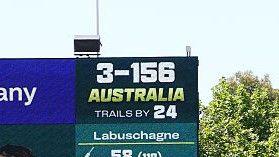Why are cricket scoreboards backwards in Australia?

- Published
Why are cricket scorecards backwards in Australia?
On Australian television, cricket scores are presented in the opposite way to what they are in England and most other countries.
For example, a score of 200-4 would actually be shown as 4-200, with the wickets taken displayed first instead of the runs.
The reason is due to Australian tradition that dates back to the 19th century and a scoreboard designed by former Australian cricketer Ned Gregory.
Gregory became the curator of the Sydney Cricket Ground but upon taking the role, decided he did not like the original English scoreboard design and felt it did not give spectators inside the ground enough information.
Gregory therefore redesigned a huge scoreboard to include a wide range of information on the match and required at least two operators to manage it.
A major design change to that saw the use of wickets before runs on the total match score, going the opposite way to how England and most other countries display their scores.
Gregory's scoreboard innovations proved hugely successful and following its implementation, other grounds around Australia soon followed.
The use of wickets before runs became tradition in Australia in stadiums and across broadcasting, with Australia keeping the format ever since.
Gregory's historic Test cricket record

Scoreboards in Australia are often displayed and referred to with wickets first
Years prior to his revolutionary scoreboard, Gregory also made Test cricket history as a player.
Gregory played in the first ever Test match for Australia against England in Melbourne in March 1877.
Australia batted first Gregory was dismissed without scoring a single run, making him the first ever Test batter to be dismissed for a duck.
This article is the latest from BBC Sport's Ask Me Anything team.
Get in touch
Send us your questions
What is Ask Me Anything?
Ask Me Anything is a service dedicated to answering your questions.
We want to reward your time by telling you things you do not know and reminding you of things you do.
The team will find out everything you need to know and be able to call upon a network of contacts including our experts and pundits.
We will be answering your questions from the heart of the BBC Sport newsroom, and going behind the scenes at some of the world's biggest sporting events.
Our coverage will span the BBC Sport website, app, social media and YouTube accounts, plus BBC TV and radio.